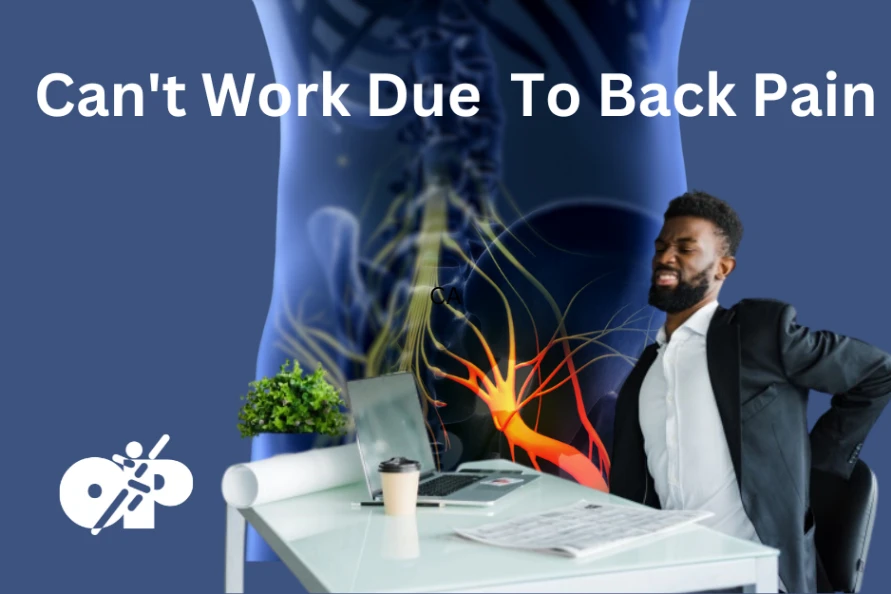In the landscape of modern work, one particular challenge has become startlingly prevalent – back pain. Increasingly, individuals across occupations find themselves uttering the phrase, “I can’t work due to back pain”. This issue transcends geographical boundaries and professional sectors, touching everyone from construction workers to CEOs.
Dr. Stewart B. Leavitt, a leading pain education specialist, highlights the scope of the problem with a staggering statistic: “An estimated 80% of the population will experience back pain at least once in their life.” This figure indicates that the problem of back pain is not a niche issue, but a global health concern.
However, the detrimental impact of back pain extends far beyond individual health. Back pain is not merely a personal discomfort or an inconvenient ailment; it has serious consequences on professional life, workplace productivity, and even the broader economy. The condition frequently leads to missed workdays, reduced effectiveness while at work, and a negative impact on overall job satisfaction. It also places a substantial financial burden on healthcare systems around the world.
Our sedentary lifestyles, often characterized by long hours in front of computer screens, coupled with physical inactivity, have escalated the incidence of back pain. But it’s not just white-collar workers suffering. Those in physically demanding jobs, where lifting heavy loads or repetitive motions are part of the daily routine, are also at a high risk.
In this in-depth exploration, we will delve into the causes of back pain, the implications it has on individuals and their ability to work, and discuss both preventative measures and treatment options. We will also explore the responsibilities and roles of both employees and employers in addressing this pervasive issue.
Understanding Back Pain
Back pain is a common condition that can range from a dull, constant ache to a sudden, sharp sensation that leaves the person incapacitated.
Pain can begin abruptly as a result of an accident or by lifting something heavy, or it can develop over time due to age-related changes of the spine.
Types of Back Pain
There are two types of back pain:
- Acute Pain that lasts less than six weeks.
- Chronic Pain that persists for more than three months.
Causes
There are numerous potential causes of back pain, but often it’s difficult to pinpoint the exact source. Common causes include:
- Muscle or ligament strain Repeated heavy lifting or a sudden awkward movement may strain back muscles and spinal ligaments.
- Bulging or ruptured disks Disks act as cushions between the bones (vertebrae) in your spine. The soft material inside a disk can bulge or rupture and press on a nerve.
- Arthritis Osteoarthritis can affect the lower back. In some cases, arthritis in the spine can lead to a narrowing of the space around the spinal cord, a condition called spinal stenosis.
- Skeletal irregularities Scoliosis, a condition in which your spine curves to the side, also may lead to back pain, but generally only if the scoliosis is severe.
- Osteoporosis Bones, including the vertebrae of your spine, can become brittle and porous, causing compression fractures.
Symptoms
Back pain can range from muscle aching to shooting, burning, or stabbing pain. Additionally, the pain may radiate down your leg or worsen with bending, twisting, lifting, standing, or walking.
Risk Factors
Certain factors might put you at greater risk of developing back pain:
- Age Back pain is more common as you get older.
- Lack of exercise Weak, unused muscles in your back might lead to pain.
- Excess weight Carrying too much weight stresses the back and can cause pain.
- Diseases Some types of arthritis and cancer can contribute to back pain.
- Poor lifting techniques Using your back instead of your legs can lead to back pain.
Prevention
You might avoid back pain or prevent its recurrence by improving your physical condition and learning and practicing proper body mechanics.
- Exercise Regular low-impact aerobic activities can increase strength and endurance in your back and allow your muscles to function better.
- Build muscle strength and flexibility Abdominal and back muscle exercises help condition these muscles so that they work together like a natural corset for your back.
- Maintain a healthy weight Being overweight strains the back muscles.
- Quit smoking Smoking reduces blood flow to your lower spine and causes the spinal discs to degenerate.
Treatment
Treatment for back pain generally depends on what kind of pain you experience: acute or chronic.
Over-the-counter pain relievers and the use of heat or cold might be enough to ease your acute back pain.
Physical therapy and proper exercise, particularly core strengthening exercises, can alleviate chronic back pain.
In more severe cases, stronger medications, chiropractic treatments, acupuncture, nerve block therapies, and surgical intervention might be considered.
The Impacts of Back Pain on Work
The effects of back pain on the workforce are not merely a matter of individual discomfort. According to the American Chiropractic Association, back pain is responsible for over 264 million lost workdays annually, which equates to two workdays for every full-time worker in the country.
Absolutely, back pain can significantly impact a person’s work life in a number of ways.
Productivity and Performance
One of the most immediate impacts of back pain on work is a decrease in productivity and performance. Back pain can be distracting and debilitating, making it difficult to focus on tasks and complete them efficiently. It might also limit the range of activities that a person can perform. For example, a person with severe back pain might not be able to lift heavy objects, sit for extended periods, or stand for long durations. Over time, this could lead to missed deadlines, poor quality of work, and even job loss.
Absenteeism and Presenteeism
Back pain is a leading cause of work absenteeism, which can have serious repercussions for both the individual and the employer. When workers are absent due to back pain, productivity decreases and other employees may need to take on additional work to compensate. The cost of sick leaves to the economy is significant. Moreover, there’s also the issue of presenteeism, which is when employees come to work despite their illness or pain. Workers experiencing back pain may not be operating at their full potential, which can lead to decreased productivity.
Mental Health Impact
Chronic back pain can also have a substantial psychological impact, which can indirectly affect work performance. Individuals suffering from chronic pain are more likely to experience conditions like depression and anxiety. These conditions can lead to difficulties concentrating, irritability, and decreased motivation, which can affect an individual’s ability to work effectively.
Economic Consequences
There are significant economic implications for individuals suffering from back pain. Medical expenses for diagnosis, treatment, and ongoing care can be high. If back pain leads to long-term disability, it might also mean a reduction in earnings or the need to change careers entirely. This can lead to financial stress and potential hardship.
Workplace Environment and Interactions
Back pain can also influence workplace dynamics. Colleagues may have to take on additional responsibilities, which could lead to tension and changes in professional relationships. Furthermore, individuals suffering from chronic back pain might withdraw from social interactions or workplace activities, which could lead to isolation and affect team cohesion.
Overall Quality of Life
Persistent back pain can significantly affect an individual’s overall quality of life, including work-life balance. The discomfort and potential mobility issues can limit participation in leisure activities, family events, or social outings after work. This reduced enjoyment of life outside of work can in turn increase stress levels, potentially creating a vicious cycle of pain and stress.
The impact of back pain on work is significant and multifaceted. It’s not just an individual health issue but a societal and economic concern. Employers can help mitigate these effects by promoting healthy work practices, providing ergonomic assessments, and supporting employees in seeking appropriate treatment.
Recommended for you:
- Eccentric Exercise Techniques for Patellar Tendonitis
- A Practical Exercise Guide for Saturday Night Palsy Patients
- Anatomy of Pain – Understanding Hamstring and Groin Pain
- Back Pain Prevention in the Workplace
Prevention, as the adage suggests, is better than cure. This is particularly applicable to back pain. Key to prevention is the application of sound ergonomic principles, which include suitable office furniture and equipment (like ergonomic chairs and standing desks), correct work postures, and workstation setup. A well-structured work routine that incorporates regular breaks, light stretching exercises, and proper hydration can significantly alleviate the strain on the back and reduce the risk of developing chronic back pain.
Back pain can often be prevented by adopting a few lifestyle changes and being mindful of how you move throughout your day. Here’s a more detailed look at these strategies:
Regular Exercise
Engaging in regular physical activity is one of the best ways to prevent back pain. Exercise strengthens the muscles that support the spine, which can reduce the likelihood of strains and sprains. Some beneficial exercises include:
- Core Strengthening Strengthening the muscles in your abdomen, back, and sides can provide better support for your spine and prevent back pain.
- Flexibility Exercises Stretches and flexibility exercises can help maintain range of motion and reduce the risk of muscle strain.
- Low-Impact Aerobics Activities like walking, cycling, or swimming can help keep the back muscles engaged and healthy without jarring or straining them.
Maintain a Healthy Weight
Excess weight, particularly around the abdomen, can strain the muscles in the lower back and lead to pain. Maintaining a healthy weight through a balanced diet and regular exercise can help prevent back pain.
Proper Lifting Techniques
Improper lifting can lead to back pain, particularly if you’re lifting heavy objects. To lift safely:
- Stand close to the object you want to lift.
- Bend at your knees, not your waist.
- Use your leg muscles to lift, not your back.
- Avoid twisting your body while lifting.
- If an object is too heavy to lift safely, ask for help or use a dolly or lifting device.
Mind Your Posture
Good posture can help keep your spine in alignment and prevent back pain:
- When sitting, choose a chair that supports your spinal curves. Your knees should be level with your hips, and you should have your feet flat on the floor.
- When standing, keep your weight balanced on your feet. Don’t slouch, and try to maintain the natural curve in your lower back.
- If you work at a desk, adjust your chair and workstation so you can sit up close to your work, with your upper body and thighs parallel to the floor.
Quit Smoking
Smoking restricts blood flow to the discs that cushion your vertebrae, which can lead to disc degeneration and back pain. Quitting smoking can help prevent this.
Regular Check-Ups
Routine health check-ups can help identify any potential issues early. If you have a history of back problems or some other risk factor for back pain, regular check-ups can be especially useful.
Stress Management
Chronic stress can lead to muscle tension and back pain. Techniques such as meditation, deep breathing, yoga, and other relaxation methods can help manage stress and prevent back pain.
Ergonomic Workspace
Your work environment should support good posture and not contribute to back strain. This includes having a proper chair with back support, setting your computer screen at eye level, and taking regular breaks to move and stretch.
These preventive measures can significantly decrease the risk of developing back pain. However, it’s essential to consult with a healthcare professional if you’re experiencing back pain, as this could be a sign of a more serious underlying condition.
Treatment Options for Back Pain
If prevention fails, there are several treatment paths available. Conservative methods, like physical therapy and pain management, are often the first line of approach. Medical treatments, such as prescription medication, injections, and even surgery, may be necessary in more severe cases. Meanwhile, for those seeking non-pharmaceutical or supplementary treatments, practices like yoga, acupuncture, and chiropractic care can offer relief and help manage chronic pain.
Employee and Employer Responsibilities
The burden of back pain in the workplace is not shouldered by employees alone. Legal frameworks exist that outline both employee rights and employer responsibilities in the case of work-related back pain. Employers are obligated to provide a safe and healthy work environment, which might mean adjustments in workload, provision of ergonomic office furniture, or even changes to work practices. Wellness programs, comprehensive health insurance, and proactive health education can help protect employee well-being. Meanwhile, employees should be aware of their rights and the steps they can take to ensure their work environment does not exacerbate their condition.
Unable to Work due to Back Pain? Final Thoughts
Back pain is a pervasive issue affecting millions of workers worldwide. While it is a common ailment, it should not be accepted as an unavoidable aspect of working life. Both employers and employees have crucial roles to play in recognizing, addressing, and preventing back pain in the workplace. Promoting back health is not just about enhancing workplace productivity; it’s about fostering holistic well-being and quality of life among the workforce.





